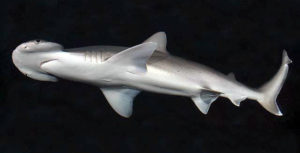Vegetarian sharks.
If you love a cheesy sci-fi movie as much as I do, the word shark probably brings a few images to mind; swimmers rushing to shore, a huge, hungry, Great white, ready to devour anything in its sights. You may have even started humming the iconic Jaws theme. But you might be surprised to hear that off the big screen, not all sharks are out for blood. In fact, one shark prefers a leafy, green, salad.
We often think of sharks as strict meat eaters, but researchers at the University of California-Irvine are turning the meat hungry shark stereotype on its head with their (mostly) vegetarian Bonnethead sharks. The Bonnethead shark is a small type of hammerhead shark often found in warm, shallow waters of the Northern hemisphere. Bonnetheads get their name from their distinct shovel-like head shape.

Though distinct in appearance, the characteristic that makes the Bonnethead shark truly unique is its diet. Sharks are infamous meat-eaters. The Bonnethead, however, prefers its meat with a side of veggies. Studies on the diet of the Bonnethead began in 2007 when large amounts of seagrass were found in the stomach of a shark in the Gulf of Mexico. For many years, it was thought the seagrass was indigestible and eaten on accident while the sharks were hunting for shrimp, mollusks, and small fish in the seagrass ridden waters. Recent research now suggests Bonnethead sharks can digest the seagrass they eat and could use it as a source of nutrients.
As the first seagrass-eating shark be discovered, there are still many questions surrounding this veggie-loving shark. Does the Bonnethead eat seagrass on purpose? Or is it accidentally consumed while hunting for creatures on the ocean floor? Perhaps the most puzzling question is how the Bonnetheads are able to digest seagrass? Because Bonnethead sharks have short intestines that are typical of a strict meat eater, scientists suspect bacteria living in the gut give the Bonnethead the ability to digest seagrass. More research is needed to discover which, if any, bacteria help the Bonnethead digest its dinner.
Although questions remain, one thing is certain; the Bonnethead shark is a unique and remarkable creature with much to teach their human neighbors about what constitutes a five-star meal under the sea.
Peer edited by Zhiyuan Liu.
Follow us on social media and never miss an article: